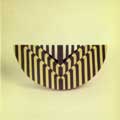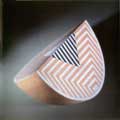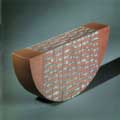 | |
| RABASOVA GALERIE RAKOVNÍK | 9 |
keramika
Wintrova síň
8. října–12. listopadu 1995

Kulový segment, výška 17 cm, šířka 37 cm, 1992
Kugelsegment, Höhe 17 cm, Breite 37 cm, 1992
Spherical segment, height 17 cm, width 37 cm, 1992

Kmitání, výška 43 cm, šířka 46 cm, 1993
Schwingungen, Höhe 43 cm, Breite 46 cm, 1993
Oscillation, height 43 cm, width 46 cm, 1993

Kulový segment, výška 21 cm, šířka 42 cm, 1994
Kugelsegment, Höhe 21 cm, Breite 42 cm, 1994
Spherical segment, height 21 cm, width 42 cm, 1994

Kulový segment, výška 21 cm, šířka 42 cm, 1995
Kugelsegment, Höhe 21 cm, Breite 42 cm, 1995
Spherical segment, height 21 cm, width 42 cm, 1995

Kulový segment, výška 42 cm, šířka 42 cm, 1995
Kugelsegment, Höhe 42 cm, Breite 42 cm, 1995
Spherical segment, height 42 cm, width 42 cm, 1995

Kulový segment, výška 45 cm, šířka 42 cm, 1995
Kugelsegment, Höhe 45 cm, Breite 42 cm, 1995
Spherical segment, height 45 cm, width 42 cm, 1995
Ve stavěných objektech Ines Büsingové zaznívá geometrické tvarosloví jako východisko i prostředek výtvarného vyjádření. Od neolitu frekventovaný tvar kruhu či koule byl nositelem symboliky solárních božstev, najdeme jej u Germánů či Keltů, stejně tak, jako na provensálské truhle. Kruh v sobě obsahuje věčné mystérium života a skonu, tajemství osudu. Koule je univerzální vesmírný tvar. Ines Büsingová je inspirována řečeným. Linie a plocha spoluvytvářejí tajemné antropomorfní tvary, jindy zdůrazňují či popírají vlastní tvar, jindy na sebe berou čistě op-artový program. Tvorba Ines Büsingové má svůj originální náboj a přes možný inspirační zdroj projevu etnických národů má své místo v toku současného evropského umění. Významným spolutvůrcem slohu této vyhraněné osobnosti je racionalita Severu. Autorka zachází s hmotou keramického materiálu bez náznaku nahodilosti. Konečným opusem díla je barva, která je často vlastní nositelkou sdělení, napětí, nápovědí.
Ines Büsingová svojí tvorbou deklaruje možnosti keramické tvorby a její pevné místo v přítomném evropském výtvarném umění.
Petr Brátka
Muzeum husitského hnutí Tábor
Als weiterer Beitrag zum Prozes des gegenseitigen Kennenlernen der Nachbaren und gleichzeitig als Beitrag zum Festival „Treffen in Tábor 95“; so kann man die Ausstellung aus dem Kunstwerk der deutschen Künstlerin Ines Büsing auftassen. Auch diese Ausstellung ist ein Beweis für die Entfaltung der Kulturaustausche zwischen unseren Ländern.
In den aufgebauten Objekten von Ines Büsing erklingt die geometrische Formenlehre als Ausgangspunkt sowie als Mittel für die bildende Äußerung. Seit dem Neolit ist die frequentierte Kreis – oder Kugelform der Träger der Symbolik der Solargottheiten, wir finden sie bei den Gennanen oder bei den Kelten, ebenso wie auf einer provenzalischen Truhe. Der Kreis umfaßt das ewige Mysterium des Lebens und des Ablebens, das Geheimnis des Schicksals. Die Kugel ist die universale Kosmosform. Durch all das ist Ines Büsing inspiriert. Die Linie und die Fläche bilden zusammen geheimnnisvolle vermenschlichte Formen, ein andermal betonen oder bestreiten sie die eigene Form, Schöpfung von Ines Büsing hat ihre ursprüngliche Ladung und trotz einer möglichen Inspirationsquelle von ethnischen Völkern hat sie ihren Platz im gegenwärtigen europäischen Künstlerstrom. Die Rationalität des Nordens spielt eine wichtige Rolle im Stil dieser ausgeprägten Persönlichkeit mit. Die Autorin geht mit dem Stoff der Keramikmasse ohne Andeutung der Zufälligkeit um. Der Schlußopus des Werkes ist dic Farbe, die oft selbst die Trägerin der Mitteilung, der Spannung, der Andeutung ist.
Ines Büsing deklariert durch ihr Schaffen die Möglichkeiten der keramischen Bildung und ihren festen Platz in der gegenwärtigen europäischen bildenden Kunst.
Petr Brátka
Museum der Hussitenbewegung Tábor
Another contribution to a process of mutual recognition of neighbours and at the same time a contribution to the Tábor's Meetings 95 Festival; in this way one can understand the exhibition of the German artist Ines Büsing. Also this exhibition proves developing culture dialogue between our countries.
In her assembled objects geometrical shapes sound both as a way out and means of creative expression. Circle or sphere shape frequently used since the neolith era was a symbol of the solar deities. It can be found at Germans or Celts as well as on the Provencal chest. A circle in itself contains an eternal mystery of live and death, mystery of destiny. A sphere is a universal space shape. Ines Busing is inspired by what was mentioned. Lines and surface create together mysterious anthropomorphic shapes. On the other hand they emphasize or deny their own shapes. Ines Büsing's work has its original charge and in spite of its possible inspiration from ethnic nations it has its own place in contemporary European art. A significant co-creator of this personality's style is rationality of the North. The author deals with mass of ceramic material without any signs of fortuity. A final result is a colour which is often a bearer of announcement, tension, suggestion.
By work Ines Büsing declares possibilities of ceramic art and its firm place in contemporary European art.
Petr Brátka
Hussite Museum in Tábor
Keramička Ines Büsingová se v Rakovníku setkává s chápajícím, poučeným, přísným, ale jak doufám i spravedlivým publikem, kterému není třeba vysvětlovat technologické postupy a zdůrazňovat technické obtíže s nimiž se musí při své tvorbě vyrovnávat.
Výroba keramiky tu je totiž nejsilnějším průmyslovým odvětvím ve městě a většina Rakovničanů má s keramikou něco společného. Dalo by se říci obrazně, že není třeba nosit keramiku do Rakovníka, stejně jako se to říká o „sovách do Athén“, nebo o „dříví do lesa“. Jenže my jsme se nerozhodli vystavovat díla paní Büsingové proto, že jsou vytvořena z hlíny a vypálena v peci, ale proto, že mají vynikající estetické kvality.
Zaujala mne především malba, kterou pokrývá povrch svých objektů. Na velmi jednoduché tvary, které mohou být stejně dobře inspirované úvahami o sluncích, hvězdách a planetách jako pohledem na pokrájený meloun, nanáší vrstvy engob pastelových tónů. Přísně geometrická osnova je nositelem veškerého výrazu, někdy pokorně sleduje tvar a pouze rytmicky člení povrch objektu. Jindy si pohraje s naším vnímáním iluzivní hříčkou vyvolávající dojem deformace tvaru a rozpínající se do okolního prostoru.
Paní Büsingová obměňuje v nekonečných variacích základní témata: křížení nebo dotyky linií, opakování stejného a proti tomu zdůraznění jedinečného prvku (třeba proříznutím, kdy malba na ploše ustoupí plastickému ztvárnění). S jednotlivými elementy nakládá jako hudební skladatel a podobnými prostředky jako on v nás vyvoláwí nejrůrnější emoce.
Protože se nikdy neopakuje a stále hledá nová řešení, její výstava se pro nás stává nevšedním a hlubokým zážitkem.
Václav Zoubek
Rabasova galerie Rakovník
Die Keramikerin Ines Büsing begegnet in Rakovník einem begreilendem, belehrten, strengem, aber wie ich hoffe auch gerechtem Publikum, dem es nicht notwendig ist die Technologie des Verfahrens zu erklären und die technischen Schwierigkeiten zu betonen, die sie bei ihrem Schaffen bewältigen muß.
Die Herstellung von Keramik ist hier nämlich die stärkste Industriebranche in der Stadt und die meisten Rakonitzer haben etwas mit der Kcramik zu tun. Man könnte bildlich sagen, daß es nicht nötig ist Keramik nach Rakovník zu bringen, wie man es auch über die „Eulen nach Athen“ sagt, oder über „das Holz in den Wald“. Wir haben uns aber nicht darum entschlossen die Kunstwerke von Frau Büsing auszustellen, weil sie aus Ton sind und im Ofen gebrannt werden, sondern weil sie ausgezeichnete ästhetische Qualitäten ausweisen.
Mich hat vor allem die Malerei gefesselt, mit denen sie die Oberflächen ihrer Objekte schmückt. Sie trägt auf sehr einfache Formen, die genauso durch Betrachtungen über die Sonnen, Sterne und Planeten, wie durch einen Anblick auf eine zerschnittene Melone inspiriert sein könnten, die Schichten von Engoben in Pastellfarben auf. Eine strenge geometrische Grundlage dient als Träger des gesamten Ausdruckes, manchmal verfolgt sie unterwürfig die Form und teill nur rhythmisch die Oberfläche des Objektes. Ein andermal spielt sie mit unserer Wahrnehmung so, daß sie durch ein kleines illusionistisches Spiel den Eindruck einer Deformation der Form und der Ausdehnung in den umliegenden Raum hervorruft.
Fratu Büsing änderet in unendlichen Variationen die Grundthemen ab: die Kreuzungen oder Berührungen der Linien, Wiederholung der selben und dagegen Betonung des einzigartigen Elementes (zum Beispiel durch Durchschneidung, wo die Malerei auf der Fläche der plastischen Gestaltung weicht). Sic geht mit den einzelnen Elementen wie ein Komponist um und ruft mit ähnlichen Mitteln wie dieser bei un, die verschiedenartigsten Emotionen hervor.
Weil sie sich niemals wiederholt und immer neue Lösungen sucht wird ihre Ausstellung für uns ein außergewöhnliches und tiefes Erlebnis werden.
Václav Zoubek
Rabasgalerie Rakovník
The ceramist Ines Büsing meets understanding, well-informed and strict, but also fair public in Rakovník. There is no need to explain them technological procedures and emphasize technical difficulties which she has to cope with at her profession.
Production of ceramics is the most dominant industry in Rakovník and most inhabitants have some contact with ceramics. One could say it is not necessary to bring ceramics to Rakovník as well as people say about „bringing coal to Newcastle“. However we have not decided to exhibit Mrs. Büsing's works of art because they are made of clay and burnt in kiln but because they have excellent aesthetic qualities.
I was impressed especially by picturing design which she covers the surface of her art works with. She applies engobe layers having pastel tones to very simple shapes which can be inspired by meditations about suns, stars and planets as well as by looking at a sliced melon. Strict geometrical design bears entire expression. Sometimes it humbly follows the shape and rhythmically breaks up the object's surface. At some other places it inspires our mind by illusion play causing impression of shape deformation and expanding to surrounding space.
Ines Büsing alters elementary subjects in infinite variations: crossing or touching lines, repeating the same and on the other hand emphasiziug unique elements (for example cutting through when surface picturing design gives way to ornamental plastic shape). She treats individual elements as a music composer and using similar means she invokes miscellaneous emotions in our minds.
As she has never repeated herself and is looking for new schemes all the tirne, her exhibition becomes unusual and deep experience for us.
Václav Zoubek
The Rabas Gallery Rakovník
Curriculum vitae
Jméno: Ines Büsingová
Adresa: Bokeloherstrasse 96
D-49716 Meppen/Ems
rok narození: 1949
1965–1969 Pedagogický odborný institut Fulda (prof. R. Sturm a prof. D. Crumbiegel)
1. státní zkouška
1969–1977 učitelská činnost na všeobecné škole Richtsberg v Marburku
2. státní zkouška
od r. 1984 aktivní práce v Meppenském uměleckém okruhu
od r. 1985 vlastní dílna
studijní cesty do USA / Pueblo keramika
Samostatné výstavy a účast na výstavách:
1986/88/90/92 účast na soutěži „obrazy“ – umění z emského kraje a hrabství Bentheim
1991 Současná keramika, Offenburg
1992 samostatná výstava v Meppenském uměleckém okruhu
Fletcher Challenge Ceramics Award, Auckland, New Zealand
Německá keramika 92 – cena Westerwald
1993 Keramika Offenburg 1993
1994 Fletcher Challenge Ceramics Award, Auckland, New Zealand
Práce ve veřejných sbírkách:
Kraj Ems
Muzeum emského kraje,
zámek Clemenswerth,
Sögel
Curriculum vitae
Name: Ines Büsing
Adresse: Bokeloherstrasse 96
49716 Meppen/Ems
Geburtsjahr: 1949
1965–1969 Pädagogisches Fachinstitut Fulda (Prof. R. Sturm und Prof. D. Crumbiegel)
1. Staatsexamen
1969–1977 Schuldienst an der Richtsberg – Gesamtschule in Marburg
2. Staatsexamen
seit 1984 Aktive Mitarbeit im Meppener Kunstkreis
seit 1985 eigene Werkstatt Studienreisen nach USA / Pueblo Keramik
Ausstelungen und Ausstellungsbeteiligungen:
1986/88/90/92 Teilnahme am Wettbewerb „Bildwerk“ – Kunst aus dem Emsland und der Grafschaft Bentheim
1991 Zeitgenössische Keramik, Offenburg
1993 Einzelausstellung im Meppener Kunstkreis
Fletcher Challenge Ceramics Award, Auckland, New Zealand
Deutsche Keramik 93 – Westerwaldpreis
1993 Keramik Offenburg 1993
1994 Fletcher Challenge Ceramics Award, Auckland, New Zealand
Arbeiten in öffentlichen Sammlungen:
Landkreis Emsland
Emslandmuseum,
Schloß Clemenswerth,
Sögel
Curriculum vitae
Name: Ines Büsing
Address: Bokeloherstrasse 96
D-49716 Meppen/Ems
Year of birth: 1949
1965–1969 Pedagogical institute in Fulda (professor R. Sturm and professor D. Crumbiegel)
1st state examination
1969–1977 teaching at the comprehensive school Richtsberg in Marburg
2nd state examination
from 1984 active cooperation in the Meppen's Art Association
from 1985 own workshop
study trips to the U. S. A. / Pueblo ceramics
Own exhibitions and participating in exhibitions:
1986/88/90/92 participating in „paintings“ competition – Art from Ems countryside and Bentheim county.
1991 Modern ceramics, Otfenburg
1992 Own exhibition in the Meppen's Art Association
Fletcher Challenge Ceramics Award, Auckland, New Zealand
The German Ceramics 92 – prize Westerwald
1993 Ceramics Oftenburg 1993
1994 Fletcher Challenge Ceramics Award, Auckland, New Zealand
Work in public collections:
Ems countryside
Museum of the Ems countryside,
chateau Clemenswerth,
Sögel
Bibliografie
Keramik Offenburg, Wettbewerb und Ausstellung, Oftenburg: Stadt Oftenburg, Kulturamt, 1991, p. 43, ill., catalogue;
„16. Fletcher Challenge Ceramics Award 1992“ in: Keramik Magazin, no. 6, Nov./Dez. 1992. pp. 22–23, ill.;
Reinhold, Harald & Görg, Bruno (ed.): Deutsche Keramik 92 – Westerwaldpreis, Tradition/Innovation/Vision, Höhrgrenzhausen: Keramikmuseum Westerwald, 1992, p. 43, ill., Catalog;
Keramik Offenburg, Künstlerische Gefaae aus Ton, Offenburg: Stadt Offenburg, Kulturamt. 1993, p. 43, ill., catalogue;
W., G.: „Keramischer Internationalismus, Der neuseeländische Fletcher – Wettbewerb 94“ in: Neue Keramik, no. 5. Aug./Sept. 1994, pp. 362–363, ill.;
